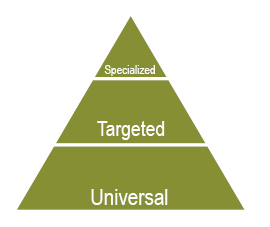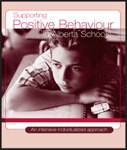
|
Universal Supports benefit all students
- Help students develop an understanding of what independent behaviour is through class discussion, storybooks, examples from literature and role-play.
- Develop classroom routines that promote and facilitate independence by providing step-by-step procedures for frequent classroom tasks and learning activities.
- Teach student specific strategies that support independence, such as:
- Teach, practise and review these routines and strategies at beginning of school year and at regular intervals throughout the year. Model and practise each strategy. Start with a limited number of steps (e.g., one to three) and gradually add more steps.
- Post visual reminders of both the importance of taking responsibility for your own learning and the importance of working independently.
- Post visual reminders of
routines and strategies so students can reference them throughout
the day. When appropriate, collaborate with students to develop
these visual reminders.
- Use descriptive feedback to reinforce individual students, groups of students and/or the whole class when they demonstrate independent behaviour in various contexts and situations.
|
|

|
Targeted Supports benefit students with more specific needs
- Pair individual students with positive peers who can serve as role models and provide support. Rotate these peers at regular intervals throughout the school year.
- Provide proximity by positioning yourself nearby individual students who may require support and encouragement in following specific routines that require independent behaviour.
- Work with individual students to develop low-key cues and prompts (e.g., pointing to the chart for classroom routines to remind the students what they are supposed to do next or "thumbs up" to encourage students to continue persevering with a task).
- Provide personalized visual checklists for routines and place them on the student's desk where he or she can see and use them independently. Some students may wish to carry the checklists with them. These visuals can also include cues for positive self-talk, such as "I can do it" or "Keep trying."
- Develop self-monitoring strategies students can use to reflect on and keep track of routines and tasks they complete on their own.
- Set up a systematic approach to reinforcement for students who are working on improving their independent work habits. Reinforcement should encourage moving toward intrinsic motivation (e.g., "How does it feel when you …?").
|
Parents know their children well and can offer insights on how to support
their social and emotional well-being. There is strength in collaborating
on strategies that could be used at home, at school and in the community.
|

|
Specialized Supports benefit the small number of students with sensory, physical, cognitive or behavioural needs that require intensive, individualized interventions
- In exceptional cases, an individual student may need 1:1 adult support to facilitate participation in classroom routines, learning activities and social interactions with other students. This support should be provided as unobtrusively as possible. In addition, the adult providing this 1:1 should collaborate with the student's learning team to identify and facilitate as many ways as possible to create opportunities, provide strategies, modify activities and adjust and/or fade support so the student can experience some degree of independence throughout the school day.
|
|








